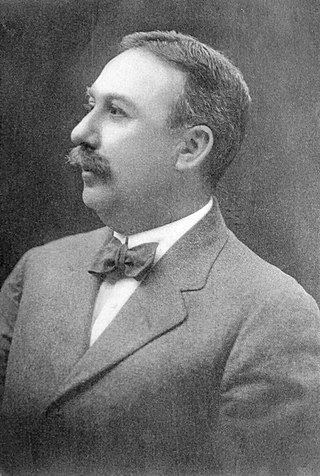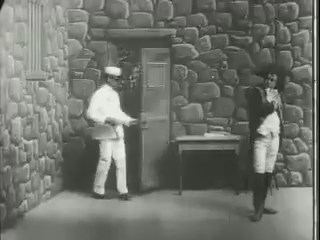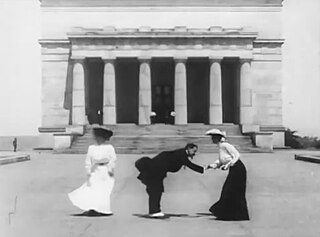
The Great Train Robbery is a 1903 American silent film made by Edwin S. Porter for the Edison Manufacturing Company. It follows a gang of outlaws who hold up and rob a steam locomotive at a station in the American West, flee across mountainous terrain, and are finally defeated by a posse of locals. The short film draws on many sources, including a robust existing tradition of Western films, recent European innovations in film technique, the play of the same name by Scott Marble, the popularity of train-themed films, and possibly real-life incidents involving outlaws such as Butch Cassidy.
The year 1901 in film involved some significant events.

Caroline Amelia Nation, often referred to by Carrie, Carry Nation, Carrie A. Nation, or Hatchet Granny, was an American who was a radical member of the temperance movement, which opposed alcohol before the advent of Prohibition. Nation is noted for attacking alcohol-serving establishments with a hatchet. She married David Nation in 1874. She was previously known by either her birth name, Carrie Moore and, after her first marriage in 1867, as Carrie Gloyd.

Edwin Stanton Porter was an American film pioneer, most famous as a producer, director, studio manager and cinematographer with the Edison Manufacturing Company and the Famous Players Film Company. Of over 250 films created by Porter, his most important include What Happened on Twenty-third Street, New York City (1901), Jack and the Beanstalk (1902), Life of an American Fireman (1903), The Great Train Robbery (1903), The European Rest Cure (1904), The Kleptomaniac (1905), Life of a Cowboy (1906), Rescued from an Eagle's Nest (1908), and The Prisoner of Zenda (1913).

The Edison Manufacturing Company, originally registered as the United Edison Manufacturing Company and often known as simply the Edison Company, was organized by inventor and entrepreneur Thomas Edison and incorporated in New York City in May 1889. It succeeded the Edison United Manufacturing Company, founded in 1886 as a sales agency for the Edison Lamp Company, Edison Machine Works, and Bergmann & Company, which made electric lighting fixtures, sockets, and other accessories. In April 1894, the Edison laboratory's Kinetoscope operation, which was about to be commercialized, was brought under the Edison Company umbrella. In 1900, the United Edison Manufacturing Company was evidently succeeded by the New Jersey–incorporated Edison Manufacturing Company. The company's assets and operations were transferred to Thomas A. Edison, Inc. in 1911.

Maniac Chase is a 1904 American short silent comedy film directed by Edwin S. Porter and produced by the Edison Manufacturing Company. The film is a remake of The Escaped Lunatic, a film directed by Wallace McCutcheon Sr. released at the beginning of 1904. This was one of two Biograph Company hits remade by Edison's company in fall 1904, the other being Personal, which was copied as How a French Nobleman Got a Wife Through the New York Herald Personal Columns.

Terrible Teddy, the Grizzly King is a 1901 American silent film directed by Edwin S. Porter. Produced by the Edison Manufacturing Company, it is the earliest known political satire in American film. It features three actors, all of whom are unknown.

Desperate Poaching Affray is a 1903 British chase film by Wales-based film producer William Haggar. Three minutes long, the film is recognised as an early influence on narrative drama in American film, especially in the chase genre. The film used a number of innovative techniques including on-location shooting, panning shots, and unconventional use of screen edges. The film, along with Frank Mottershaw's film A Daring Daylight Burglary, is considered to have helped launch the chase subgenre and influenced Edwin S. Porter's The Great Train Robbery.
George S. Fleming was an American actor, director, and scenic designer whose short films were influential early projects in the medium.

Love by the Light of the Moon is a 1901 film by Edwin S. Porter, produced by the Edison Manufacturing Company. It mixes animation and live action and predates the man in the Moon theme of the 1902 French science fiction film A Trip to the Moon by Georges Méliès. The animation is provided by projected slides showing the Moon's different faces.
Parsifal is a 1904 American silent film produced by the Edison Manufacturing Company and directed by Edwin S. Porter. It is based on the 1882 opera Parsifal by Richard Wagner, and stars Adelaide Fitz-Allen as Kundry and Robert Whittier as Parsifal.

Dream of a Rarebit Fiend is a 1906 silent trick film directed by Edwin S. Porter for Edison Manufacturing Company. It is a seven-minute live-action film adaptation of the comic strip Dream of the Rarebit Fiend by American cartoonist Winsor McCay. The film was marketed as using several special effects in which "some of the photographic 'stunts' have never been seen or attempted before."
How Brown Saw the Baseball Game is an American short silent comedy film produced in 1907 and distributed by the Lubin Manufacturing Company. The film follows a baseball fan named Mr. Brown who overdrinks before a baseball game and becomes so intoxicated that the game appears to him in reverse motion. During production, trick photography was used to achieve this effect.
The Bold Bank Robbery is a 1904 short crime film produced and distributed by the Lubin Manufacturing Company. The silent film depicts a group of burglars who plan and execute a successful bank heist. Company employee Jack Frawley was the film's director, also coming up with the story and serving as cinematographer; the cast's identities are unknown. The silent film was the first Lubin Manufacturing Company release to feature an original narrative.

The Count of Monte Cristo is a 1913 silent film adventure directed by Joseph A. Golden and Edwin S. Porter based on Alexandre Dumas' 1844 novel of the same name. It starred James O'Neill, a stage actor and father of playwright Eugene O'Neill. James O'Neill had been playing Edmond Dantès most of his adult life and was famous in the role. Daniel Frohman and Adolph Zukor produced together. Edwin S. Porter co-directed with Joseph Golden, though this was probably necessary as Porter also served as the film's cinematographer. The film was released on November 1, 1913.

The 'Teddy' Bears is an American silent film directed by Edwin S. Porter and Wallace McCutcheon, and produced by the Edison Manufacturing Company starting as the fairy tale Goldilocks and ending as a political satire of United States President Theodore Roosevelt.

Life of a Cowboy is a 1906 American short silent Western film produced by Edison Manufacturing Company and directed by Edwin S. Porter.

Laura Comstock's Bag-Punching Dog is a 1901 silent short film directed by Edwin S. Porter. The film depicts a vaudeville act featuring Laura Comstock and her trained dog, a pit bull named Mannie. Comstock's act was currently appearing at Keith's Union Square Theatre.

How a French Nobleman Got a Wife Through the New York Herald Personal Columns is a 1904 silent comic film directed by Edwin S. Porter for the Edison Manufacturing Company. The film is a remake of the hit film Personal, produced by the Biograph Company earlier in the year. The film is a spoof of the "fashionable marriages" known to take place between cash-strapped European nobility and American heiresses.

Why Mr. Nation Wants a Divorce is a 1901 silent short comedy film directed by Edwin S. Porter and George S. Fleming. It is a satire on the activities of radical temperance advocate Carrie Nation, who was known for her crusade against bars and taverns. Earlier in 1901, Porter directed another film mocking Nation, Kansas Saloon Smashers; this follow-up film was inspired by news reports that Nation's husband demanded a divorce.
















